It has been a little over six months since I last released the Los Angeles Kings’ top 10 prospects list, so now seemed like a good time to update the list. Since that article was released, a few players have graduated to full-time NHL players, and four new players were drafted, leaving plenty of room for movement on the list. Like last time, players who are full-time NHL players, or have finished their rookie season already will not be considered for this list. Meaning, Rasmus Kupari, Arthur Kaliyev, and Sean Durzi won’t be in consideration, nor will Gabriel Vilardi or Jaret Anderson-Dolan.
Honorable Mentions: Tyler Madden, Jordan Spence, Kirill Kirsanov
#10. Samuel Helenius
Kicking off the list is 2021 second-round draft pick Samuel Helenius. The Kings traded up to draft the towering Finn, one of three players the team traded up to draft in 2021. He’s a player who screams high floor low ceiling, he has all the tools to become a staple on the team’s bottom-six for a long time but comes with offensive limitations that will stop him from being anything more than that. Kings’ Director of Amateur scouting made no secret of where they see Helenius in the teams’ lineup moving forward during his post-draft interview, he was drafted for a specific role and looks perfect for it. As Yannetti put it, this is a roster-building pick.
Helenius has made big strides since the draft as well, while his straight-line skating has always been very good for someone with his size, his lateral movement was an issue at the draft. He still needs more work before that aspect of his game is NHL ready, but he has already made big improvements in that area. He’s also still very limited offensively, his hands in open ice are below average and he lacks the creativity and passing to be a distributor for the Kings.
Related: Kings Prospects Excel at Rookie Faceoff Tournament
But, the things he does well, he does extremely well. The defensive side of his game is far more developed than most people at his age, he rarely gets sucked out of position and displays an active stick defensively. You also can’t ignore his massive 6-foot-6 frame, especially the way he uses it, he’s already a physically imposing player in Liiga, a men’s league. At just 19-years-old, he’s going to add plenty of muscle before joining the Kings, and will physically dominate in the NHL as well. Already excellent in the faceoff circle, the added muscle will also help him dominate in the dot. The son of former NHL enforcer Sami Helenius, he shares his dad’s aggressive playstyle, and it will be interesting to see if he adds fighting to his game as he develops.
Despite his offensive limitations, there are still positives offensively. His hands in and around the net are good, and he displays a good wrist shot. His wrist shot is hard and accurate if he’s given the time to load it up. He doesn’t have the release to consistently beat goalies in the NHL, but will score goals when given the time and space to unleash his shot. He’s great at screening the goalie and picking up tips and rebounds in front of the net, which adds to his goal-scoring potential. Overall, he projects as a bottom-six center with some goal-scoring upside. The earliest I see him joining the Kings is the 2023-24 season, as he’ll need time to develop in the American Hockey League (AHL), and when he does make the jump, I think he’ll project very similar to Winnipeg Jets’ center Adam Lowry.
#9 Francesco Pinelli
Coming in at the number nine spot is another 2021 draft pick, second-round pick Francesco Pinelli. After playing limited hockey in 2020-21 due to COVID shutting down the Ontario Hockey League (OHL), he’s back with the Kitchener Rangers and playing great hockey. His 29 points in 21 games lead the Rangers and puts him 10th in the league for points among under-19 players, a higher ceiling but lower floor than Helenius, he dropped to the No. 42 spot in the draft, with many scouts expecting him to go in the first round. Concerns surrounding his compete level and consistency were the main reasons for him dropping in the draft, with his skill being undeniable.
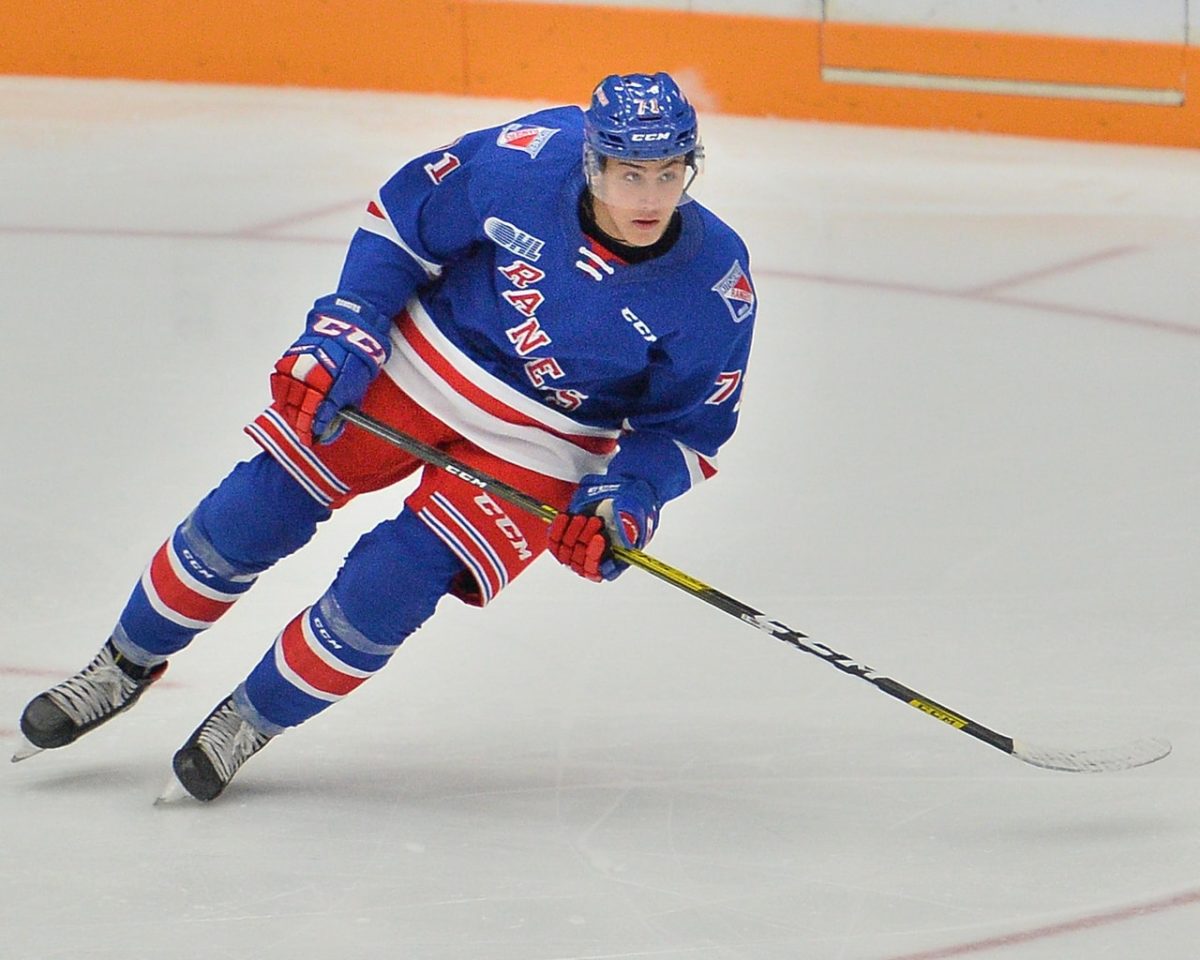
When Pinelli is on, he’s a 200-foot center who can impact the game in all three zones. He is an excellent skater who utilizes it both offensively and defensively, he has a very complete package offensively, with an elite hockey IQ tying his skills together. He also can pull out flashy plays with the puck, but can sometimes try these moves too often. This is where his consistency issues come into play, in one shift he will pull the puck around a defenseman with one hand on his stick, and then in the next shift, he will lose the puck on a simple backhand-forehand move. He too often tries to make a flashy move when a simpler, more efficient move would be better and it burns him on occasion. In the offensive zone is also where the concerns surrounding his compete level come into play, he can get caught playing too much on the perimeter, unwilling to get involved in the dirty areas of the ice.
Fortunately, his fantastic hockey IQ gives him an edge on most players. He reads the game very well, allowing him to process plays quickly and make the right decision in an instant. Again, his consistency issues can hinder this offensively, as he can get caught dallying on the puck on occasion. Still, he has shown on multiple occasions that he can play the game at a high pace, and this will help him transition into the NHL easily. I think he projects as a winger in the Kings system, simply because the Kings are so deep at center. If he can iron out his compete and consistency issues, he will become a player who can play in any role in your top-nine, who can put up good numbers if paired with highly skilled linemates. I’d look to Connor Brown of the Ottawa Senators as a good comparable.
#8 Helge Grans
Two spots ahead of where he landed last time I made this list, Swedish defensemen Helge Grans has done a great job transitioning his game to the smaller North American rinks in his first AHL season. There have even been suggestions that the smaller rink helps him defensively, as it is easier for him to utilize his long reach. With eight points in 18 games, he is one of just four under-20 defensemen in the AHL and is leading them in points. While he has made some improvements defensively, it’s still his play with the puck that makes him an intriguing prospect. He is a big player who can skate, and shows great vision. Once in the offensive zone, he walks the blueline with precision and can make high-skill plays from the top of the zone. When shooting he prefers to creep down into the zone so he can take wrist shots, and probably needs to work on his slap-shot if he wants to consistently provide a goal threat in the NHL.

If you want to get a sense of Grans’ game, just watch his play against Russia at the World Junior Championships, and this game perfectly summed him up. He was great on the power play, quarterbacking the man advantage and grabbing two points. He was also mostly good 5v5, using his skating and size well to transport the puck from defense to offense. But, he had some big mishaps defensively. His defending on Russia’s first goal was some of the worst I’ve seen, he showed terrible gap control, gave up the middle of the ice, and lost a puck battle down low which all led to the goal, he also had a massive turnover to Matvei Michkov that was fortunately turned wide. His play outside of these mistakes means that he was still a positive impact on the game, but he will always be a high-risk high-reward kind of player.
There’s still plenty of work to be done before I commit to him being a lock for the NHL, but his development over the last six months makes me more confident than ever that he will make the jump. His gap control and defensive position are still too inconsistent, but his upside ceiling is still very high. If he continues developing at this pace, we could see him get NHL game time by the end of the 2022-23 season, but I wouldn’t expect him to become a regular until, at the earliest, the 2023-24 season. He was drafted as a long-developing project and that’s still what he is. As a comparable, I would look to Mikhail Sergachev with the Tampa Bay Lightning, a big player who skates well and provides a good offensive impact, the tendency to make mistakes that lead to goals is there, and they’ll always leave you wanting a little bit more defensively.
#7 Brock Faber
It’s back-to-back defensemen on the list, with 2020 second-round pick Brock Faber coming in at number seven. Despite having a lower ceiling compared to Grans, Faber lands one spot higher than the Swede because of a much higher potential floor. In his sophomore season at the University of Minnesota, he has been one of the best defensemen in college hockey, anchoring the Golden Gophers blueline. An interesting tidbit on Faber, he currently plays with Ryan Johnson with Golden Gophers, who is the son of Ontario Reign assistant coach Craig Johnson. After quickly earning the trust of his coaches as a freshman last season, he has continued to be a go-to player for them, eating up huge minutes as a sophomore. Had the World Junior Championships not been canceled early, we would have seen him take on a similar role for team USA as well.
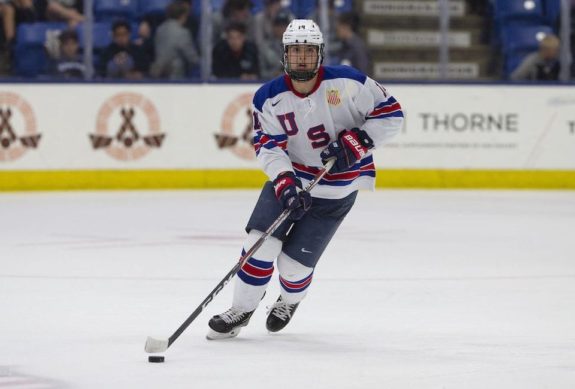
He has very little flash to his game and will rarely ever get fans on their feet because of a big play, but he does all the little things right. There are no holes in his game defensively, he plays physically in the corners, blocks shots, and uses excellent skating to funnel players wide before dispossessing them. He executes clean breakout passes consistently and can use his skating to evade incoming forecheckers, but his offensive game pretty well ends after that. He rarely jumps up into the play, and if he is going to make something happen offensively he does it from the blueline.
If he does find himself in the top four for the Kings, it will likely be next to a more offensive defenseman providing cover for a player who likes to take risks and jump into the play. He should join the Ontario Reign at the end of this season, once his college season is finished, and will probably need one more season of development in the AHL before joining the Kings. As a comparable, I would look to Artem Zub of the Ottawa Senators.
#6 Akil Thomas
Switching back to another forward, 2018 second-round pick Akil Thomas comes in at number six. After a stellar rookie season in the AHL last season, he’s been limited to just two games this season because of injury. He finished second on the Reign in total points last season and provided his usual defensive stability. This season was meant to be a late start for him as he required double shoulder surgery over the summer, but an injury in his second game back from surgery has extended his time in the press box. Missing what would have been his second professional season is a big blow to Thomas’ development, but he’s one player who you should never count-out.
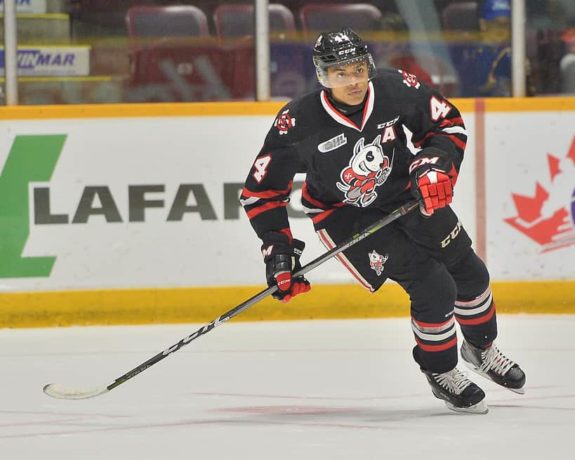
Despite the lack of development, the organization still has plenty of faith in Thomas. A relentless player with a motor that never stops, you can always count on him to outwork his opponent on every shift. He’s also defensively very good, to the point that the Reign planned on giving him a few games on defense during their defensemen crisis in late December before his injury. He’s more than just a defensive grinder though, with fantastic speed, stickhandling, and vision, he has shown the potential to be a solid playmaker at every level. He also brings the always coveted, “intangibles” that coaches love so much, at just 22-years-old he’s already one of the most mature players in the organizations, and no one would be surprised to see him wear a letter at some point.
Had it not been for injuries I think we would have seen him make his NHL debut at some point this season. Around this time next year, I would imagine he will be in the mix for a call-up and he’s a player who I don’t think will see the AHL again once he gets a taste of the NHL. I’d expect him to develop into a similar player to Calle Jarnkrok of the Seattle Kraken.
#5 Martin Chromiak
By far the biggest riser on this list, Martin Chromiak kicks off the top-five. He didn’t make the list last time, but since then he has lit it up everywhere he has been. He’s one of the best players in the OHL, dominated the Summer Showcase he attended for Slovakia with nine points in three games, had two good games during the World Junior Championships, and put together a very strong development camp with the Kings. Chromiak’s stock is rising quickly and it’s easy to see why. I was most impressed with him during the Arizona Summer Showcase he played in with the Kings, he looked very comfortable on a line with Quinton Byfield and Arthur Kaliyev and was the team’s best player at times. I was especially impressed by his versatility, he was very willing to get in quickly on the forecheck and make life difficult on defensemen, something you don’t always see from highly skilled players.
While he is a pretty well-rounded player offensively, it’s his shooting that sets him apart. He is a very complete shooter and can beat you with several shots from multiple distances. Wrist-shot, snap-shot, one-timer, he can do it all with power, accuracy, and a good release. He’s also an above-average skater and uses that to his advantage well, he can back off defenders and give himself space to shoot or use his speed to beat players wide and drive to the net. He is a very creative stickhandler and a good passer, although he’s a shoot-first kind of player.
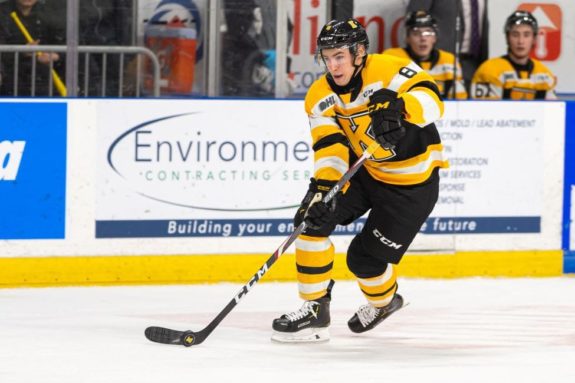
There are still concerns about his defensive positioning, as he can get lost in his own zone and get caught cheating while looking for goal-scoring opportunities. But these are easy issues to fix, so I wouldn’t be too concerned. There are a few snipers in the Kings’ prospect pool who Chromiak has to compete with but given his current development path, he may earn his spot on the team in the future. I don’t think he doesn’t have the potential to be a 30-goal scorer in the NHL, but I do think he can develop into a consistent 20-plus goal, middle-six winger. As a comparable, I’d look at Anthony Duclair of the Florida Panthers.
#4 Samuel Fagemo
Samuel Fagemo is certainly one of the names that come up when speaking about snipers in the team’s prospect pool that Chromiak will compete with, and he comes in at number four on this list. Fagemo announced himself to the hockey world during the 2020 World Junior Championships, leading the tournament in goals and points. After a strong rookie season in the AHL last season, he came into this season hoping to build on his 10 goals and eight assists in 2020-21. Unfortunately, there hasn’t been an increase in production from the Swede, but that doesn’t mean there’s been no development. He’s made big improvements to his 200-foot game and is slowly adapting to North American hockey. His goal totals are also on a similar pace to last season, so I think there’s very little to worry about concerning his production in the AHL this season.
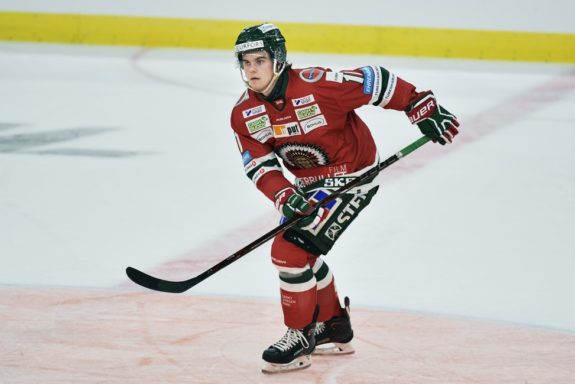
Fagemo is a goal scorer through and through, he possesses one of the deadliest shots in the organization. He’s second only to Kaliyev in that respect, solid skating, and good enough stick handling. Despite having an awkward stride, Fagemo has a very good top speed which he can reach in just a few strides, while his edgework and lateral movement are good, but not great. His stick handling is simple yet effective, he doesn’t pull out fancy tricks often but can beat defenders with quick stick moves. His passing is also a decent weapon, but one he very rarely uses, as he is a shoot-first player. It’s his shot that sees him so high on this list, like Chromiak, he is a very complete shooter who can beat you in a variety of ways.
What sets Fagemo apart from other shooters, is his release. He needs minimal time and space to get off hard, accurate shots. In instances where other players would look to make an extra move, or shoot for a rebound, he picks corners. His ability to change the angle on his shot just before release makes it very hard for goalies to make saves. He also has an uncanny ability to find open ice in the offensive zone. It’s often said that the puck gravitates towards goal scorers, and that’s very true for Fagemo. With his defensive game and edgework improving, I’m more confident in him now than I was six months ago.
His NHL point totals will rely on his power-play time, as he does a lot of damage with the man advantage. If he is given significant time as the trigger man on a top power-play unit, he has the potential to score 30-goals, if not, I think he’ll settle in as a consistent 20-goal top-six winger. As a comparable, I’d look at Jakub Vrana of the Detroit Red Wings.
#3 Alex Turcotte
Kicking off the top-three is 2019 fifth-overall pick, Alex Turcotte. It’s been an up and down season for Turcotte, who has dealt with all too familiar injury issues, made his NHL debut, and is now in COVID protocol. Injuries have stunted his development, as he hasn’t had an injury-free season since 2017-18, two seasons before he was drafted. He put together a strong rookie season in the AHL in 2020-21 playing mostly as a winger, but has returned to his natural center position this season. His offensive numbers don’t jump off the page, but his two-way game and play driving are very developed for someone who is still just 20 years old. The hope that he would develop as a true number one center is almost certainly gone, but he still has the potential to be a fantastic top-six forward, who posts a few All-Star seasons.
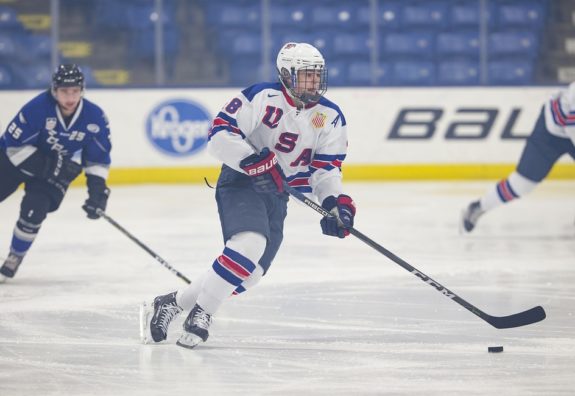
Turcotte is still a player with almost no holes in his game, the only knock you can give him is in his shooting. He lacks the power to beat goalies consistently at the highest level, but other than that, there aren’t many negatives. Everything he does stems from his elite hockey IQ, coming from a family of incredible hockey players, and arguably better hockey coaches, it’s no surprise that he is one of the most intelligent players out there. He also displays great puck skills and creativity, which has made him a fantastic playmaker at lower levels. Possessing a motor that never stops, he excels at retrieving pucks in the corners and making plays in and around the net. While he is likely to develop into a more defensive center in the NHL, there’s is still plenty to like about his game offensively.
While there is still a small chance his offense explodes in the next few seasons, I would expect him to develop into a very responsible second line center, who takes the difficult matchups away from Quinton Byfield and the first line. Turcotte is the kind of player who makes everyone around him better and will develop into someone who posts fantastic analytics. If the offense doesn’t come, a good comparable for him would be current Kings center Phillip Danault, if his offense does develop, St. Louis Blues captain Ryan O’Reilly would be a good comparable.
#2 Brandt Clarke
In the penultimate spot sits 2021 eighth overall pick, Brandt Clarke. Despite his shocking snub from team Canada’s World Juniors camp, the 2021-22 season has still been fantastic for Clarke so far. His 1.19 points per game (PPG) leads all defensemen in the OHL and he earned himself an NHL contract after an outstanding showing at development camp. A player who has a very high ceiling, but comes with a few red flags, which saw him fall to the Kings at number eight. Some mock drafts had him as the second defensemen picked after Owen Power because of his ceiling, but ultimately his deficiencies were enough to deter teams, and the Kings might have made out like bandits because of it.
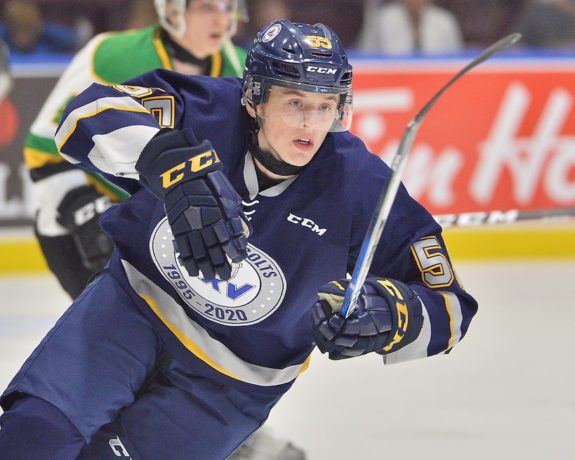
I’ll get the negatives out of the way first, Clarke has one of the weakest, most inefficient strides I’ve ever seen from a high-level hockey player and this issue does raise some concern. During Kings’ development camp he tested near the bottom of the group during their stride power tests and it’s easy to see why. Clarke stands up too straight when skating and is unable to generate power with his strides, if this isn’t fixed, it will be an issue when players with size and speed attack him one-on-one, and when he tries to fight off forecheckers. Fortunately, his speed and lateral movement are still very good, but he needs to improve his power. Extensive work with a skating coach should quickly fix this issue. There have been concerns about his defensive positioning and awareness as well, but I think fixing his stride will alleviate a lot of these issues.
Now onto Clarke’s positives, few players possess the vision and poise with the puck that Clarke does. When he gets the puck he can dictate the pace of play and move the game at whatever speed he decides. Be it a quick breakout or a home run stretch pass, he makes his reads quickly and strikes. He also loves jumping up into the play, he knows when to pick his spots and activate as a fourth forward, creating odd-man rushes. This vision also makes him an excellent quarterback on the power play, allowing him to facilitate from the point. He doesn’t have an overly dangerous shot, but he does well to creep down into the zone and find opportunities to shoot. He needs to add power to his slap shot, but that should come with adding muscle. He has elite offensive awareness and puck skills which allows him to make plays others can’t and will lead to him posting some fantastic numbers in the NHL.
Had it not been for his weak stride and perceived defensive issues, Clarke would have been a lock to go in the top three of his draft. Instead, he fell to the Kings at number eight, and they were able to grab their heir to Drew Doughty. If he works with a skating coach and fixes the issues in his stride, Clarke will develop into a premier offensive defenseman who can eat up big minutes. For a comparable, I’d look at John Klingberg of the Dallas Stars.
#1 Quinton Byfield
Retaining his number one spot on this list, had it not been for an ankle injury during preseason, Byfield would likely not be eligible for the list. All signs pointed towards an NHL breakthrough before that ankle injury in early October. After a strong rookie season where he finished second in points for 18-year-olds in the AHL, second to Cole Perfetti who is eights months older, the plan was for him to break onto the Kings roster this season. With that not happening he has returned to the Reign, for the time being, looking to regain his conditioning before his season debut with the Kings. He struggled for offense through six games in the AHL, but still one of the youngest players in the league, and coming off a serious injury, the shouldn’t be any worries about his development. He has also shown huge improvements in his 200-foot game.
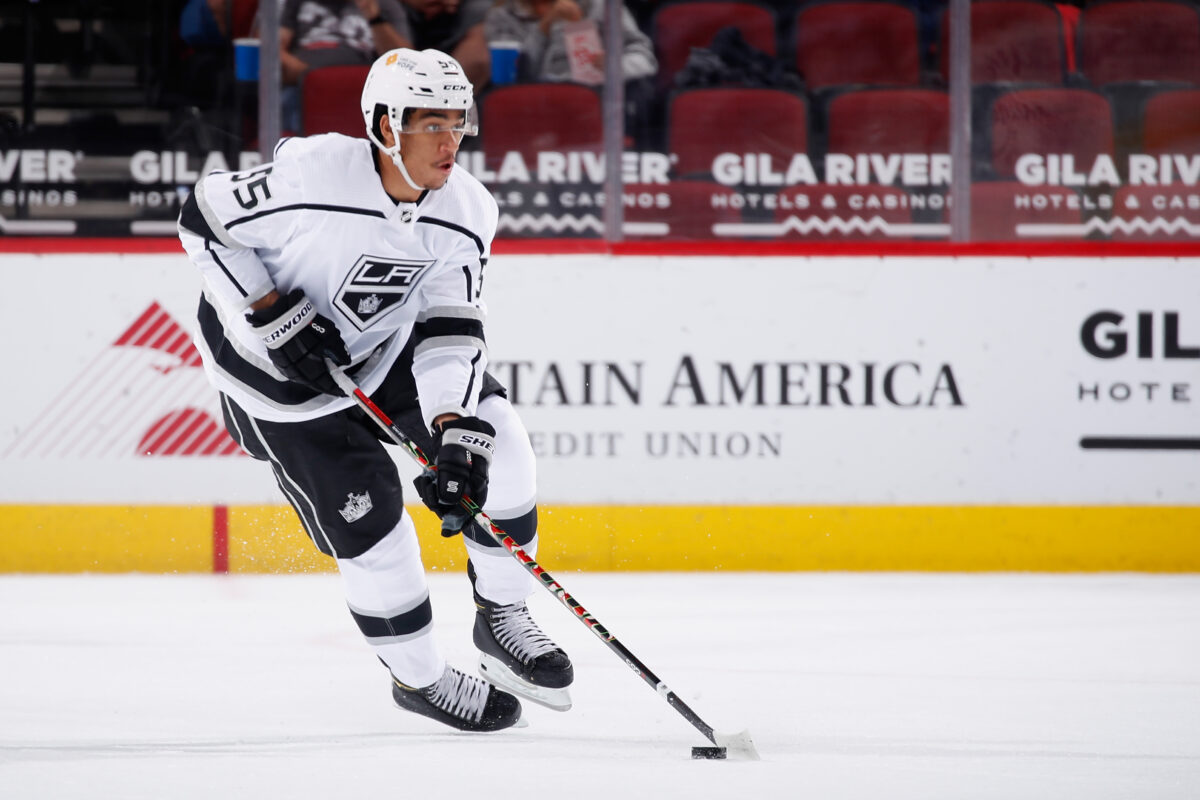
More of a project than some other second overall picks, I don’t think many people would argue that he has the highest ceiling of any player drafted in 2020. He’s currently listed at 6-foot-4, 216-pounds at just 19 years old, with elite skating, stick handling, and hockey IQ, there are very few players who possess the toolset Byfield does. He can drive play, dominate physically, post huge offensive numbers, and play a sound defensive game, the sky is the limit for Byfield. Consistency is the only knock on him right now, as he doesn’t use these tools to dominate often enough. But, something that I will always remind people of when talking about Byfield, is how young he really is. Had he been born a month later, he would have been the first overall pick in the 2021 draft and not available for the Kings in 2020.
As I said, the sky is the limit for Byfield, his potential ceiling is that of a franchise player who will be in the mix for the Hart Trophy in some years. His blend of size, speed, and skill is very unique in the NHL and sets him up to be one of the league’s best playmakers for the next decade. Of course, he needs to find the necessary consistency to dominate games regularly, but once he discovers that, the league is in trouble. I expect him to earn a spot in the Kings lineup by the end of this season and will be a lock for the roster next season. The best comparable for Byfield since day one has been Evgeni Malkin, and that’s still true to this day.
One of the League’s Best Prospect Pools
With a great mix of elite talent and depth roster players, the Kings still have one of the best prospect pools in all of hockey. We are starting to see players like Kupari and Kaliyev make an impact in the NHL, and it’s a safe bet that more prospects will make an impact over the next few seasons. While it’s true that not everyone can make it in the NHL, and some players won’t reach their potential ceiling, Kings management has set themselves up incredibly for the future and should see the fruits of their labor at the draft win them plenty of hockey games over the next decade.